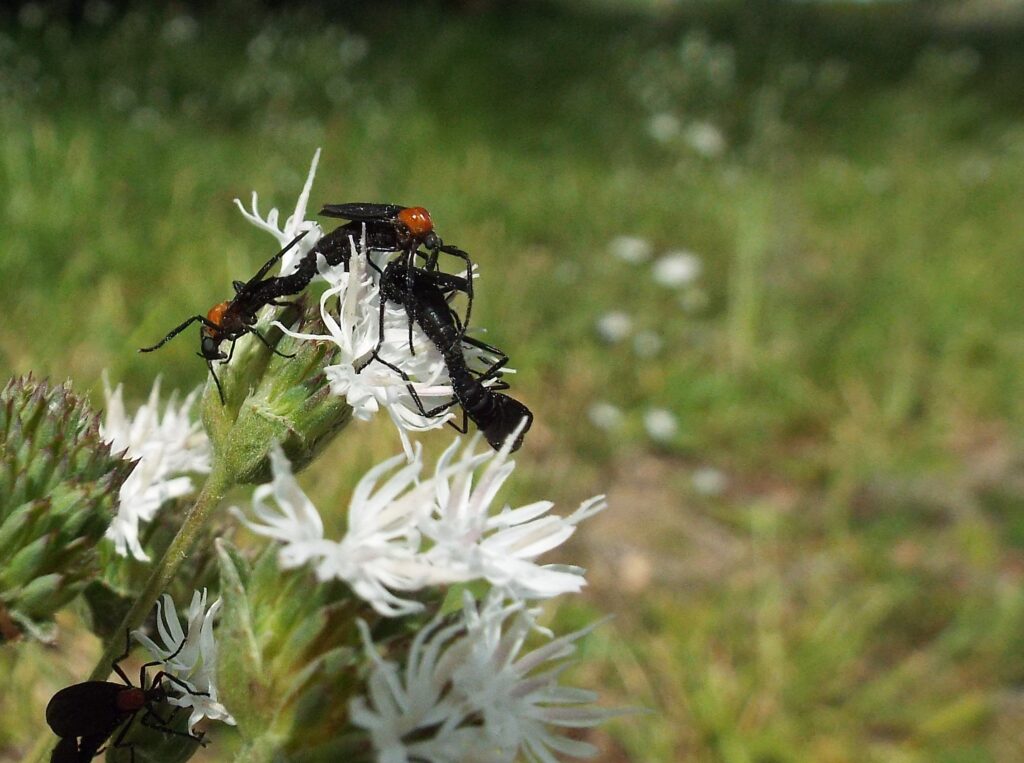

This week for Flora and Fauna Friday we have the bane of windshields, the living smoke of spring, that monogamous miasma seeping beneath the door jam. This week we’re surrounded by Lovebugs (Plecia nearctica).
Lovebugs are a species of Fly native to the Gulf Coast. They lay their eggs in the damp, warm soil found beneath leaf litter, rotten logs, hay, and compost. Their half-inch long, gray maggots peacefully feed on decaying plant material in the soil for several months before pupating. In mid-May this tranquil existence is wrenched asunder by a hedonistic haze issued from the Earth. The eclosure of the adult fly. Adult Lovebugs are just over a quarter inch long with a prominent orange thoracic mantle floating upon an oily black body. These bicolored bugs emerge en masse into a frenzy of passion. The species earned the common name Lovebug from their reproductive behavior of coupling together, end to end, and remaining attached for the remainder of their lifespan. Lovebugs are most often seen in these mating pairs. Each fly only lives a few days but an emergence can last for weeks. There are two emergences per year, with the major emergence in mid-May and the minor in mid-September.
Lovebugs tend to congregate in open areas like fields, roadways, and yards. They are attracted to reflective white surfaces such as wildflowers, vehicles, and walls. This can make them quite the nuisance. They hover around homes, adhering to the occupants on their arrival and departures. They cling to parked cars and hitch rides within the cab. They make their way through every seam and threshold where afforded the clearance. They can even be economically damaging when blanketing the roadways. The Flies clog radiators, etch enamel paint, and obfuscate vision as they collide with cars. Their flesh is highly acidic. This makes them unappetizing to predators and can even eat through car paint if left uncleaned. But, even this spring swarm has its upsides. The Lovebug larvae are important parts of the nutrient processing cycle, accelerating decomposition of plant material to make the nutrients trapped inside it available to plants again. The adults are critical pollinators for many small wildflower species. As the Lovebugs feed on nectar, bumbling their way across the flowers in search of it, they collect and distribute pollen wherever they roam.
Lovebugs were not always prevalent on our Island. The species is native to Central America but, around the turn of the 20th century, they had made their way to the Gulf Coast. Over the next 50 years, they gradually spread throughout the coastal plain of the southeastern US, including Edisto. There is a second species of Lovebug (Plecia americana) that is native to South Carolina. This species is less common, lives in woodlands, and only emerges in spring. It’s distinguished by having a solid orange thorax, both above and below.


This week for Flora and Fauna Friday we’re greeted by a large and lavish legume. This week we’re gazing upon Coralbean (Erythrina herbacea).
Coralbean is a member of the legume family. Legumes, best known by their edible members, like peas, peanuts, beans, and soy, are a large and varied clade of plants. These species are, for the most part, characterized by large seeds in long dehiscent pods, bilaterally symmetrical flowers, tri-foliate leaves, and the ability to fix nitrogen from the air. However, the family is incredibly diverse and many species do not share all these traits. Coralbean however, does share all of these traits. Coralbean is best recognized by its large size, arrowhead-shaped leaves, long crimson flowers, and coral beans.
Coralbean grows in sandy soil in partial shade in open understory habitats. Coralbean is often found on hammocks and along forest edges. In Central America, Coralbean can exceed 15ft in height. The species is frost intolerant though and dies back to its roots here on the island, normally never exceeding 4ft in height. Other than an annual frost nip, Coralbean is none the worse due to winter, remaining quite a hardy species. In mid-spring the plant begins to flower, producing spiked clusters of long, tubular, red flowers. These stunning blooms are a favorite of hummingbirds. The fruit of coral bean is similar in size and shape to Pole Beans but the difference lies within. Come summer the fruits dry and split, revealing their prize. The seeds of Coralbean are a brilliant scarlet color and dangle by a hair from the schism in the hull. This color is meant to attract birds who disperse the seeds. However, unlike many plants that offer wildlife an incentive to eat their seeds, Coralbean seeds are naked and toxic. The toxicity discourages animals from chewing the seeds. Yet, Coralbean offers them no calorie bribe, like a Dogwood or Magnolia seed would. Thus their seeds are mostly ignored by wildlife.
Coralbean, like the majority of legumes, can fix atmospheric nitrogen. Legumes are not alone in this feat as several other plant groups share the ability. Actually, the plant itself cannot fix nitrogen but it forms a mutualistic relationship with soil bacteria who give it access to this critical element. These bacteria live in special root structures called nodules. Nodules look like small spheres stuck to the side of a plant’s roots. In here the bacteria live and capture nitrogen from the air in exchange for shelter and food. Nitrogen is a crucial element for life. It’s a vital ingredient in the synthesis of DNA and proteins. It also makes up 78% of the air we breathe. Yet, plants can only access this element when it’s in a handful of chemical compounds and also dissolved in soil water. Nitrogen is typically the third-most limiting factor in plant growth, behind sunlight and water. Plants that can fix nitrogen have a distinct advantage in that they can turn sunlight and water into sugar and then exchange that with soil bacteria in return for useable nitrogen compounds. This allows them to outcompete their neighbors in poor soils but increases their requirements for both water and sunlight. This is why beans do well in poor soils but still do better when ample nitrogen is provided.
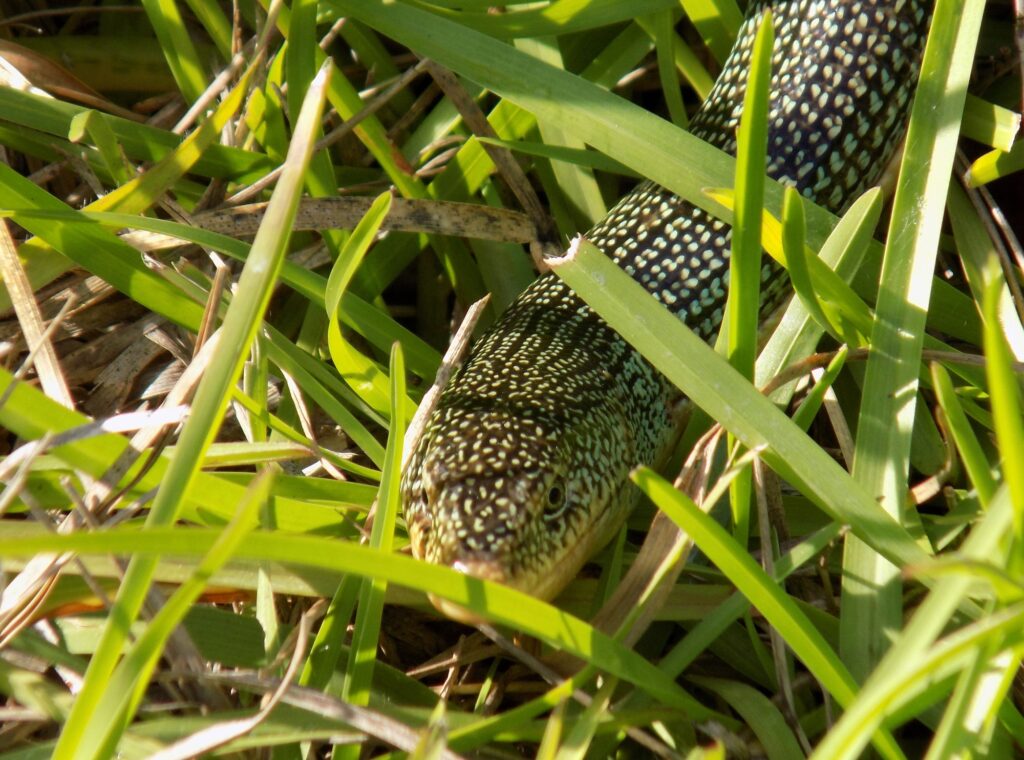
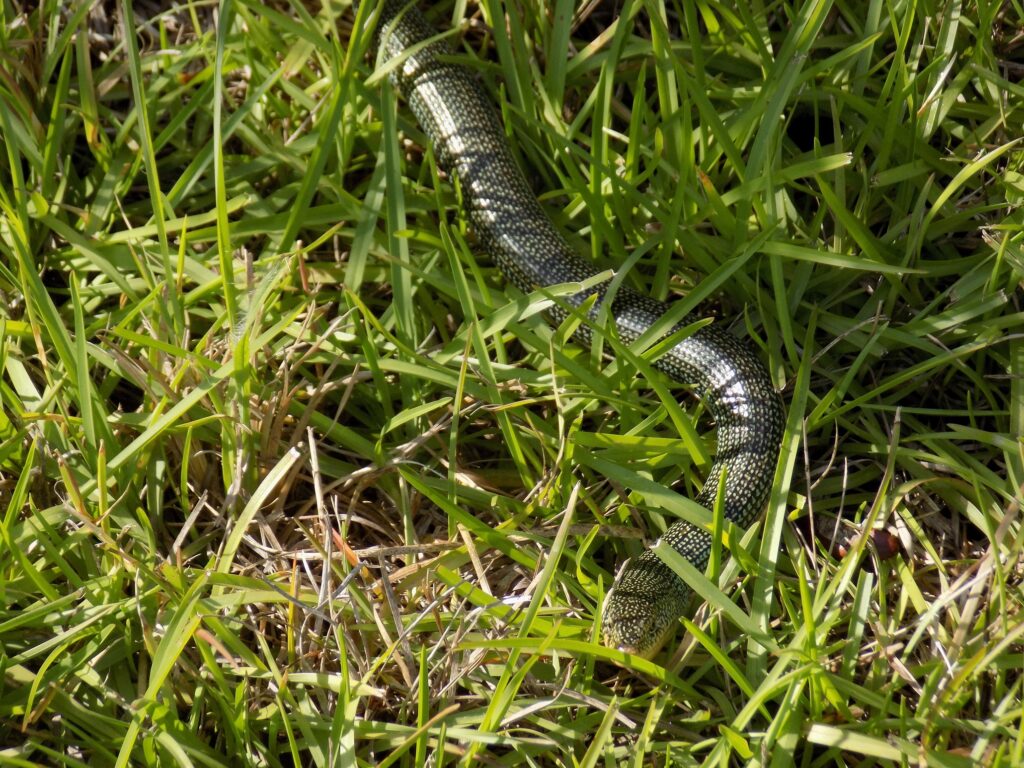
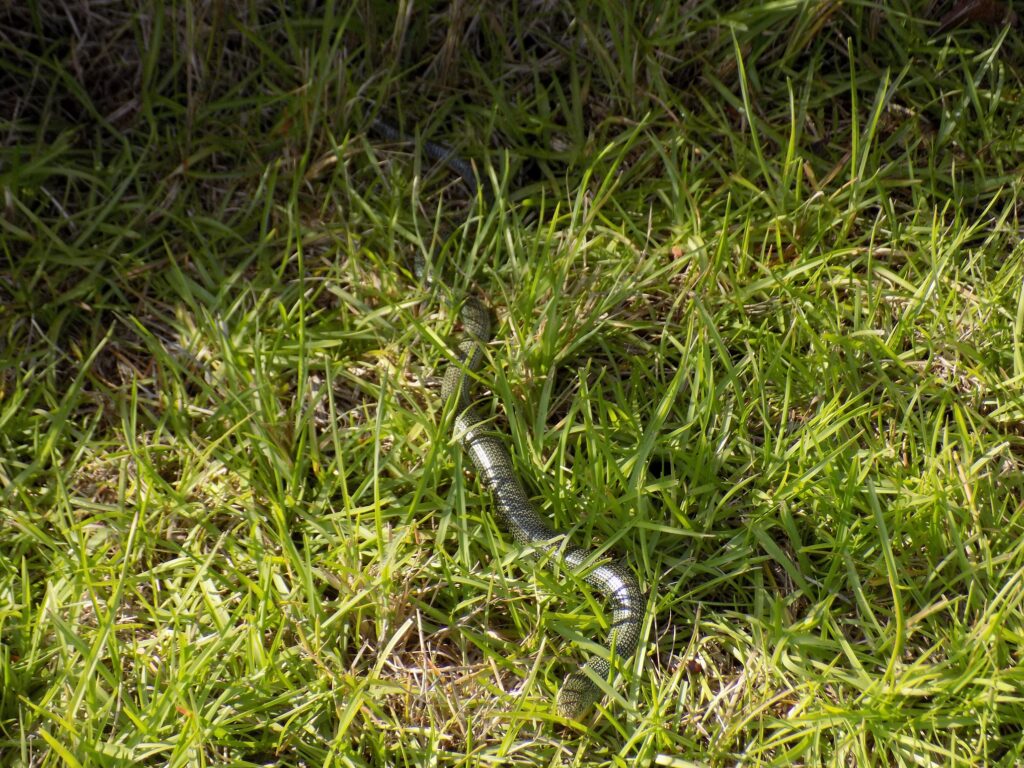
This week for Flora and Fauna Friday we have a fragile creepy crawly who’s often misinterpreted as a different rope-like reptile. This week we’re peering into the world of the Eastern Glass Lizard (Ophisaurus ventralis).
Glass Lizards, as the latter name implies, are a species of lizard. There are four Glass Lizard species in our area but the Eastern Glass Lizard is by far the most common. These lizards often misidentified as snakes due to their legless condition. However, I assure you, they are absolutely lizards and absolutely harmless. There are some distinct physiological differences between the two groups. Snakes have thin needle-like teeth, flexible jaws, and kill with venom or constriction. Glass Lizards have stout triangular teeth, strong inflexible jaws, and kill small critters with a crushing bite. Snakes can crawl by undulating their ribs or wriggling their entire body. Glass Lizards can only move by wriggling. Glass Lizards are not venomous and are totally harmless. Although, they can deliver a painful bite if mishandled.
The Eastern Glass Lizard is a large lizard with piercing eyes and a distinct lack of legs. This longitudinal lizard is thinly cylindrical in its general shape and can reach over 3 feet in length. The species is variable in coloration. Younger lizards are usually a warm brown on top striped with black and white along the sides. Adults can maintain that patterning but usually develop a blackened back studded with sea-foam flecks. All ages lack any dark stripes below the lateral groove. This is the best superficial feature to distinguish the Eastern Glass Lizard from the other three Glass Lizard species. Glass Lizards spend most of their time hunting beneath brush, debris, leaf litter, or amidst grass. They’re most often spotted when sunning out in the open. They use burrows excavated by other animals to escape into or hibernate within. Glass Lizards get their common name from one of their defense mechanisms. Glass Lizards primarily avoid predators by remaining motionless and then darting away at the last second. Although if cornered, they will violently wriggle, release a foul smelling musk, and then break in half. They can shed their tail in one or more pieces. (The amount of tail lost can be almost half their body length!) The ease with which they depart from their terminal appendage landed them the common moniker. The abandoned body part continues to wriggle after the schism. Usually, this sacrificial sausage is enough to satiate, or at least distract, a predator and allow the Glass Lizard to escape out of sight. The tail will regrow but will take several months to do so.
This week for Flora and Fauna Friday, we have a pastel spring thing. This week we’re appreciating the Fleabanes, genus Erigeron.
Fleabanes are a member of the Aster family and, like all the other members, they have a compound head flower. Their flowers are a white to pastel pink with a rich yellow center. Fleabanes are different than most asters in that they have both very small and very complex flowers. These half inch or smaller flowers can sometimes possess over 150 ray florets per bloom! (That doesn’t even count the disc florets!) There are four species of Fleabane native to our island: Oakleaf (E. quercifolius), Daisy (E. strigosus), Early Whitetop (E. vernus), and Philadelphia (E. philadelphicus).
Oakleaf Fleabane has large lobed leaves that resemble a White Oak’s wrapped in a velvet coat of hairs. The plants are short and don’t get more than a foot high. Their flowers are on the showy end and tend towards being strongly pink with many ray florets. Oakleaf Fleabane prefers partially-shaded, moist forest openings and tend to grow in large patches. They bloom from mid to late spring.

Daisy Fleabane has thin blade-like leaves with little pubescence. The plants can grow up to three feet high and have a sparse, open look to them. The flowers are primarily white and are roughly the same size and complexity as Oakleaf Fleabane’s. Daisy Fleabane prefers sunny, dry and sandy areas where other vegetation is sparse. It blooms from mid-spring through summer.

Early Whitetop Fleabane boasts small but oval succulent leaves. It can reach two feet in height with leafless flower stalks. Each flower stalk is topped with a half dozen or so flowers that are strongly white with a bright yellow center, resembling Asters (Symphyotrichum spp.) more than Fleabanes. Early Whitetop Fleabane grows in moist and sandy soil, particularly in Pine Savannas. It blooms in early spring.
Philadelphia Fleabane is very similar to Oakleaf Fleabane in many respects. However, it’s leaves are less deeply lobed and lack much of any velvet. The flower stalks tend to be taller with more prominent leaves and bloom later into the summer.
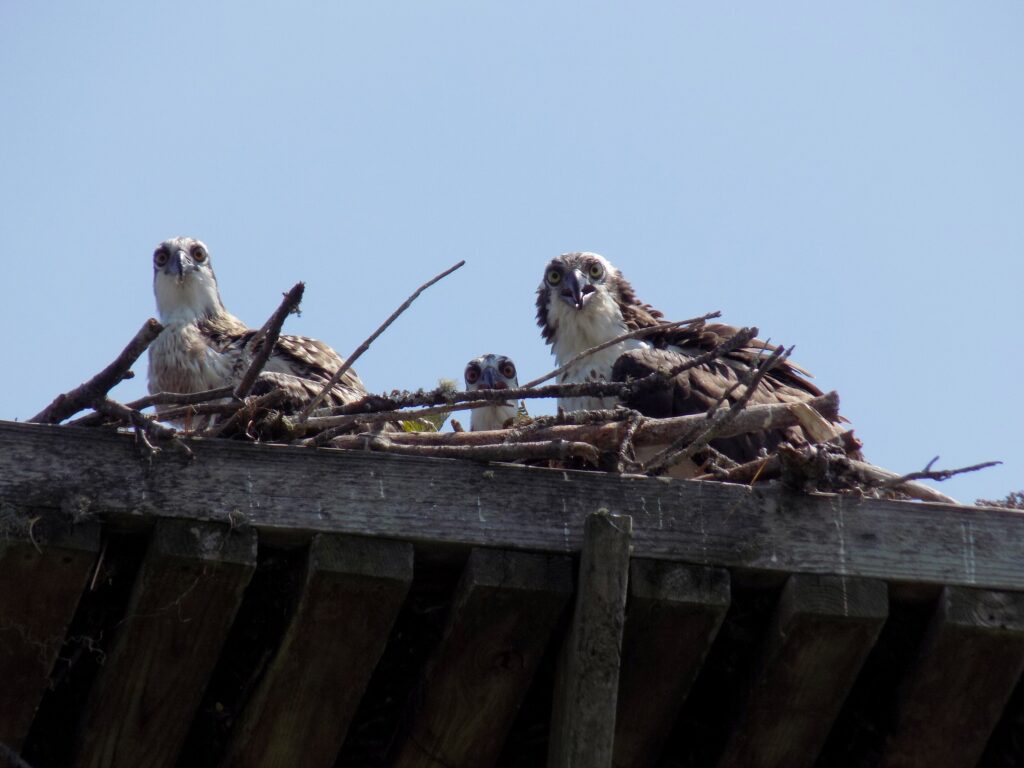
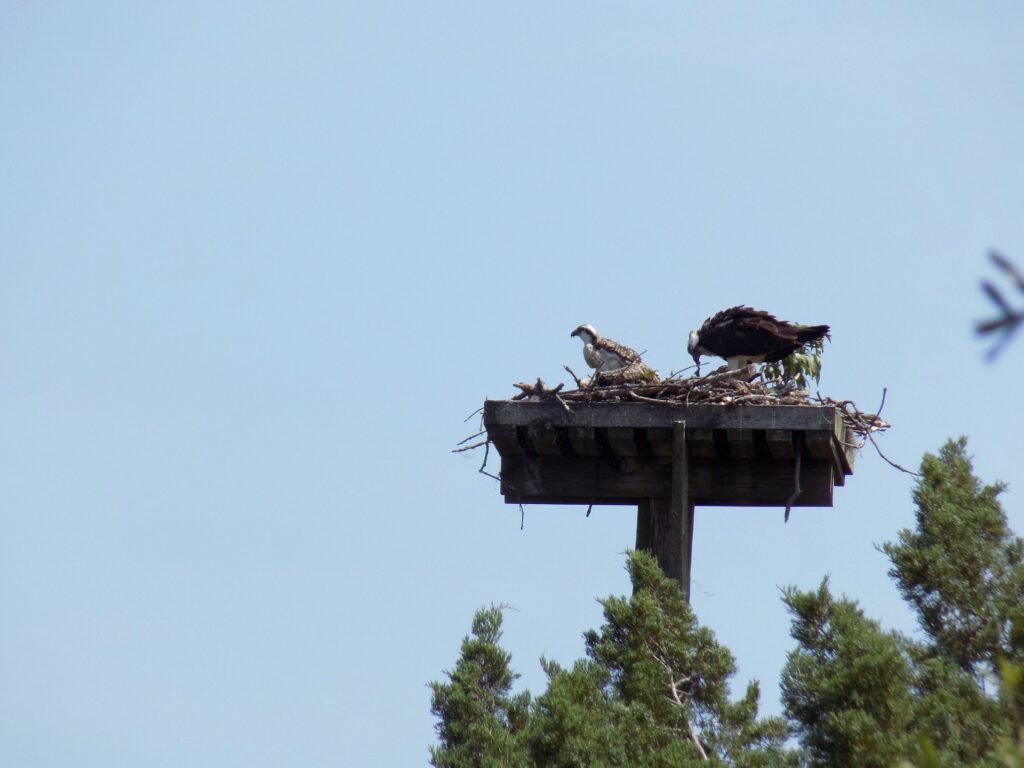
This week our guest of honor is the Osprey (Pandion haliaetus), also called a Fish Hawk.
The Osprey is a large bird of prey that eats exclusively fish. Their pelage is monochromatic. A pearl white canvas stroked and shaded by charcoal. Males set themselves apart with a band of coffee streaks across their chest. Their figure is sleek and slender but with wings of impressive breadth. Their bill is stout and sharply hooked, over which clear and expressive eyes set in topaz gleam. A black mask wraps their face, blending into a disheveled, shaggy mane of feathers. Their feet are set wide with sickle-tipped toes and barbed scales. Inverted treble hooks of articulated muscle and bone fit specially to this aerial angler.
Ospreys employ these claws with daredevil-esque courage for devastating effect. Osprey use their broad wings to glide high above the surface of the water. Their sulfur eyes peeled and darting between the wakes. A school of fish is identified. Wings arch with powerful beats, suspending the Fish Hawk amidst the wind. In this suspension a quarry is determined and a trajectory calculated. Wings lock back and feet lock forward as the Osprey goes into freefall. The raptor hits the surface of the water, feet forward and claws outstretched, at 50 miles per hour. The impact drives its feet to the fish and its claws through the fish before the prey can even react. The Osprey spreads its wings at the last moment to lift it back into the air, fish in tow in toes. They’ll carry their catch facing forward, like a torpedo bomber, away to their nest or a branch to feed.
Osprey are a cosmopolitan species, meaning they are found across the Earth. They’re found wherever there is land beside a large body of water. They can be seen on the beach, over the lake, down the river, along the creek, or across the marsh. Ospreys are a common sight here in the Lowcountry, where they build their landmark nests. Ospreys mate for life and can reuse the same nest their entire lifespan. In the wild, Ospreys build large dish shaped nests from sticks and moss in the highest crook of a dead tree. This gives the hunters protection from egg eating predators and the visibility to guard against flying foes. However, with humanity’s ever expanding telecommunication and utility infrastructure, the Osprey has discovered a new preferred nesting habitat: power poles and cell towers. It’s true, we’ve inadvertently created a worldwide network of ideal nesting habitat for a global bird species. Although this nest preference does cause issues for both the linemen and the Osprey, it may have been critical in the species’ survival and recovery, especially in an ever more deforested landscape.
Osprey populations were decimated in the mid-1900s by the widespread use of the pesticide DDT. This pesticide runs-off into water systems and bioaccumulates. This causes the poison to concentrate in the flesh of aquatic organisms, with concentrations rising exponentially as you move further up the food chain. Because of this, species that fed primarily on large fish, like the Osprey, accumulated the highest concentrations of DDT in their bodies. DDT had the side-effect of making eggshells paper-thin, dropping nesting success dramatically for all but the most remote populations. Thanks to bans on DDT, increased government protection, and that excess of nesting habitat in an increasingly deforested landscape I mentioned, the species was able to recover with a vengeance!


This week for Flora and Fauna Friday, we have a Lazarus-like epiphytic fern, Resurrection Fern (Pleopeltis michauxiana).
Resurrection Fern is found throughout the Southeast. Its preferred habitat is humid hardwood forests. However, you won’t find this fern amidst the grasses and asters of the forest floor. You must shift your gaze upward. Resurrection Fern is an epiphyte. An epiphyte is a plant that grows entirely on the surface of a larger plant. Epiphytes are different from species like Mistletoe. Mistletoe steals water and nutrients from within the tree, harming it directly. Epiphytes don’t harm their host directly. They get all of their water and nutrients from the air and whatever gets trapped on the bark of a tree. (Spanish Moss is an epiphyte too.) Resurrection Ferns are a common sight blanketing the Atlas-esque boughs of the Live Oak or cradled in the creases of the Bald Cypress’s buttress. This fern forms a thick mat of roots along the bark of Live Oaks, enveloping the tops of limbs in a feathery shag carpet. These root mats can be peeled off the bark and transplanted to other trees. Like other Ferns, Resurrection Fern disperses its offspring with windblown spores, taking hold on wet tree bark.
What makes Resurrection Fern special and gives it that common name, is its remarkable ability to survive prolonged periods of drought. For epiphytes, water can be hard to come by if it doesn’t rain. To resist the whims of the weather, Resurrection Fern has developed the ability to survive desiccation. The plant simply allows itself to dehydrate as its water supply dries up, putting the plant in a metabolic stasis. These Ferns typically lose about 75% of their water content during short droughts and can even survive losing over 95% of their water! For perspective, when making beef jerky, beef loses 75% of its water content and when making raisins, grapes lose 80% of their water content. That’s pretty parched if you ask me! As Resurrection Fern dries, the leaves turn brown and curl upward, exposing their undersides. This curling helps prevent further water loss and presents the absorbent underside of the frond to any incoming rain. Following a rainstorm, the plant will fully revive within a day!
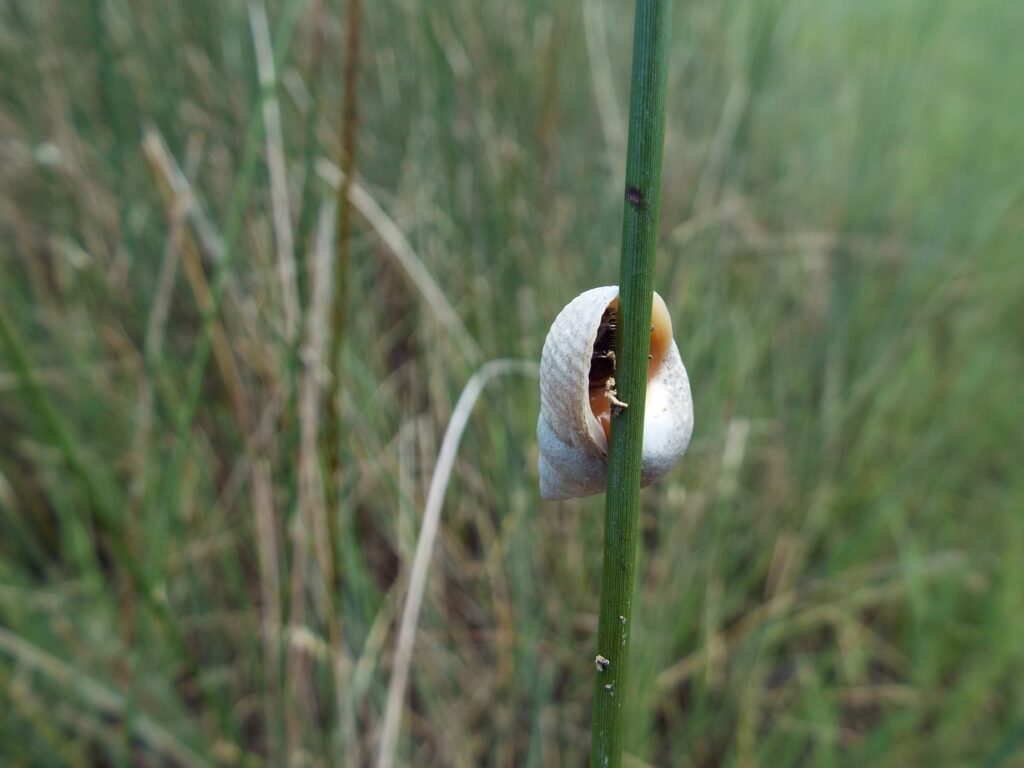
This week for Flora and Fauna Friday, we have a climbing, salty, adhesive snail on display, the Marsh Periwinkle (Littoraria irrorata).
Marsh Periwinkles are a small species of aquatic snail native to the salt marshes of the Southeast. They are less than an inch long, about the size of an acorn. The snails have a dense, conical shell with a coarse texture and the color of unfired potting clay. Their shells are typically coated in a patchy layer of lichens and algae. This shell offers the snail protection while it goes about its daily life. Although stout, this shell can’t protect them from everything. They are a favorite food of Blue Crabs, Sheepshead, Terrapins, and Redfish. To avoid these larger predators, Marsh Periwinkles have developed an interesting strategy. As high tide arrives, exposing the snails to the dangers in the surf, they retreat up the stems of the Cordgrass and Rush to several inches above the water line. Here they glue themselves to the plant stem with extra thick snail slime before retreating into their shells. This use of adhesive allows the snail to close its shell up tightly with its foot, preventing it from drying out in the sweltering South Carolina sun and the continuous dehydrating breeze.
The species is prolific along the coast throughout the low saltmarsh. There can be a dozen periwinkles living in a square foot of marsh. They live amongst the Smooth Cordgrass, feeding on algae and fungi that coat the stems of the plants. Periwinkles, like other gastropods (snails, slugs, and such) have a feeding structure called a radula. A radula is like a tongue covered in teeth and functions like a pliable carpenter’s rasp, projecting from the mouth and scraping away a meal from the surface beneath it. Marsh Periwinkles have a preference for eating fungi rather than algae. So much so, they will actually farm certain species of fungi on the stems of Cordgrass. The snails will use their radula to cut away the skin of a grass stem, exposing the plants vasculature to the water and infection. With luck (for the snail), a fungus will begin to infect the plant and the Periwinkles will return to feed on the fungus in this infected wound. The snails will create these fungal food plots across the stems of the plant and throughout the stand of marsh. If environmental conditions take a turn for the worse, these community-wide fungal infections can cause a mass dieback of the Cordgrass and leave the snails homeless.
This week for Flora and Fauna Friday we have an elegant forest dweller content to live its life outside the spotlight of the sky. This week we’re appreciating the Flowering Dogwood (Cornus florida).
Flowering Dogwood is a small species of tree adapted to life in the forest midstory. The midstory of a forest is a vertical location, below the canopy in between the trunks of the dominant trees but above the limbs of the brush, an arboreal interstice. Dogwoods don’t do well in full sunlight and prefer to spend their lives beneath the envelope of the forest canopy. As such, they are short and slow growing with dense crowns of wide elliptical leaves to help soak up the scattered light that trickles through the canopy. This slow growth makes their wood extremely dense and quite tough but remarkably pliable, especially when green. Their bark is finely fissured and blocky, with a reptilian appearance.

Dogwood’s humble ecology is not all that gives it significance in our landscape. That would be its spring display. As the names suggests, Flowering Dogwood produces a magnificent display of flowers when in bloom. Its crown is laden with large white flowers at the tip of every branch. A second snowfall to celebrate the passing of winter. These flowers appear four-petaled. However, in reality these mock-petals are but bracts, modified leaves. The true petals are found in the center. The small green-yellow flowers are found in a cluster at the heart of the bloom. These disguised blooms give way to scarlet drupes, a one seeded fruit, in summer that are enjoyed through the fall and winter by the birds of the woods. In winter, Dogwoods shed their leaves and retreat within that frigid meditation. Yet, the large spherical buds that cap their twigs foretell of the splendor of next year’s display, patiently waiting to echo the final snowflake.
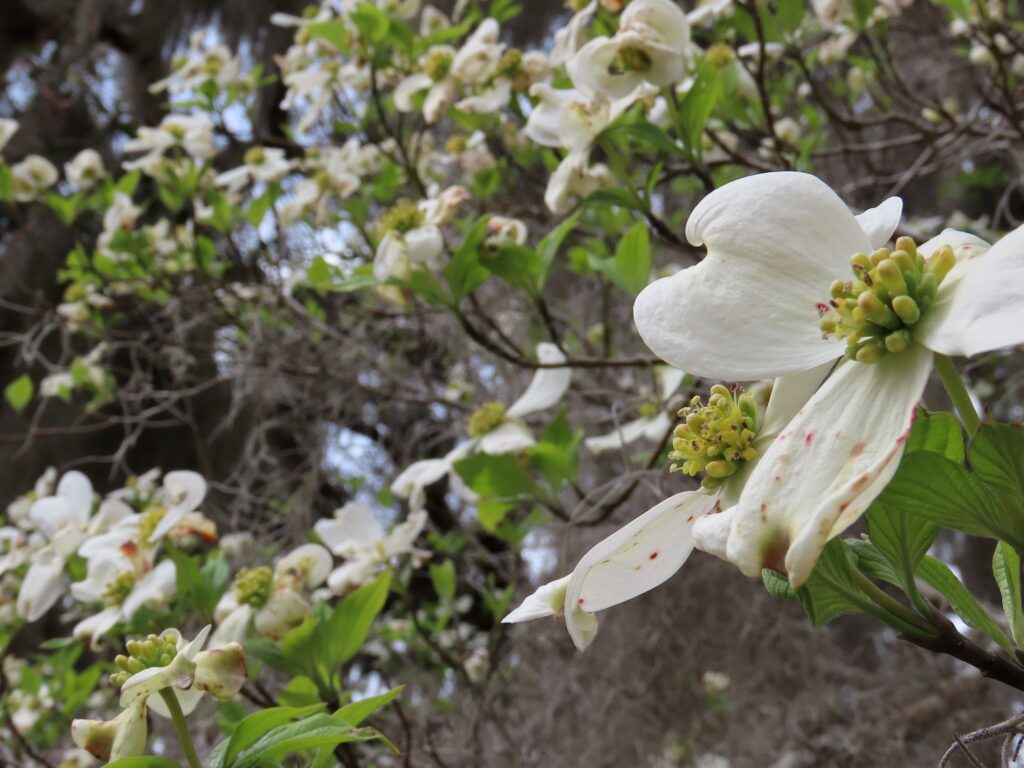
Dogwoods are currently under attack in the Southeastern US from a fungus. A disease is called Dogwood Anthracnose. The disease begins as dark spots on the leaves of the tree, slowly spreading through the leaves and eventually into the twigs. From there, the fungus makes its way beneath the bark into the branches of the tree, killing off limbs as it moves. If it eventually spreads throughout the trunk, it will kill the tree. Late stage infections can be identified by excessive epicormic budding on the main branches and trunk. Epicormic budding is where a tree will produce new branches from below the bark on the limbs and trunk. An Anthracnose ridden tree will be covered in small branches all along its trunk. This auxiliary growth is a natural response to damage in the tree’s vascular network, such as losing a branch or girdling. This disease harms trees in wet habitats and full sun the most. These are areas where the plants are already under environmental stresses and are not able to fight off the disease indefinitely.




For Flora and Fauna Friday this week we have the bold and boisterous bug-eating bird born beneath brushpiles, the Carolina Wren (Thryothorus ludovicianus).
The Carolina Wren is the state bird of South Carolina and one of my personal favorite species. They are small, stocky, energetic, curious, and loud. A ball of condensed gregariousness. The Carolina Wren sports a warm brown pelage barred with black, flecked with white, and suffused with smoldering rufous tones. A stern white eyebrow mirrors a longish decurved bill, both anchored beside intelligent mocha eyes.
Carolina Wrens are small songbirds at only 5 inches in length. What they lack in size they make up for with personality. They are vociferous vocalists, singing, calling, and chattering with prodigious pipes that seem beyond their frame. They can often be heard (typically well before they’re seen) perched atop a shrub or fencerow projecting a rhythmic song into the air or bobbbing-and-weaving while spitting short calls at the surrounding landscape. Their songs are highly variable but typically consist of a three-syllable phrase repeated four times but cut off abruptly during the fourth repetition. The Onomatopoeias I’ve heard for this phrase include “deepwater”, “teakettle”, and “cheeseburger” but the spoken word changes from bird to bird, day to day, and song to song. Breeding pairs will often perform duets where the male begins his song and the female will provide chattering back up vocals mid-verse. Carolina Wrens mate for life and don’t migrate. The pairs patrol a permanent territory throughout the year. They build nests in cavities or thick tangles of brush.
Carolina Wrens can often be seen bounding through brushpiles, flitting under forests, hopping beneath hedges, pecking around patios, and sidling down sidewalls. They are in constant motion patrolling eaves, bushes, and crevices for spiders, crickets, caterpillars, and beetles. They will occasionally visit birdfeeders, mostly out of curiosity, but will occasionally dine of cracked corn and suet. They are accomplished generalists found throughout the eastern United States in forested habitats, scrubland, woodlots, and suburbia. They have good spatial awareness compared to other songbirds and will frequently mosey into garages, porches, and sheds in search of spiders without becoming lost and trapped.
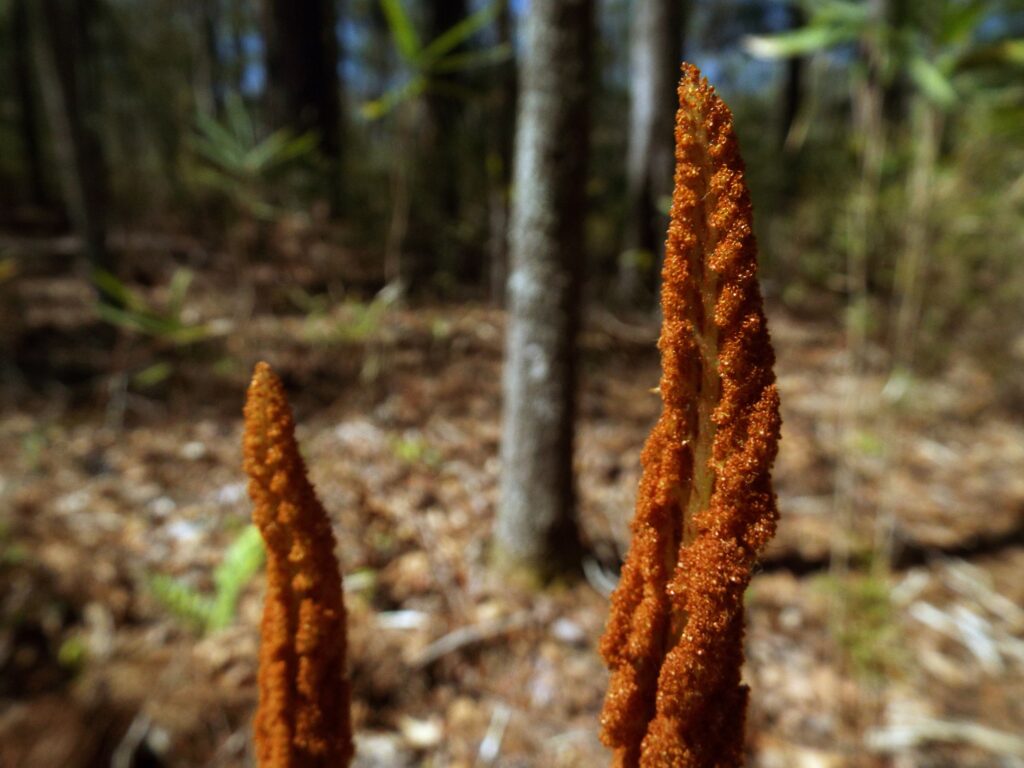
This week for Flora and Fauna Friday we find the first fern for the series. This week the subject is Cinnamon Fern (Osmundastrum cinnamomea).
Cinnamon Fern is a common species found throughout the forests of South Carolina. It prefers moist woodlands and floodplain forests. It is a large fern that can exceed 4ft in height. They are found both solitary and in large colonies. The species is a living fossil that has existed relatively unchanged for over 75 million years. The species produces large fronds that it holds erect above the forest floor. An easy way to identify cinnamon fern is by the clumps of fine reddish hairs at the nodes of the stem. The fronds are divided twice, and quite finely, giving them a feathery appearance. These divided leaf sections are called pinnae. These large leafy fronds are called sterile fronds and are used for photosynthesis. In the center of these sterile fronds, fertile fronds emerge. These fertile fronds are shorter, thinner, and point straight upward. The fertile vegetation has a granulated appearance and reddish-brown color, much like cinnamon.
This distinction between fertile and sterile fronds is made because ferns are not flowering plants or even seed-bearing plants. They produce no flowers, fruits, or seeds. They are more ancient vascular plants and reproduce with spores and in a manner similar, but different, to fungi. The almost microscopic sporangium can be thought of as the fern equivalent of a flower. The sporangia are borne on the underside of the leaves and are typically clustered in orange colored-spots called sori. In Cinnamon Ferns, the fertile fronds are almost entirely made of sporangia, lending the fronds their namesake color and granulated appearance. These spores require a wet surface to germinate and grow into a tiny specialized life stage called a gametophyte. This life stage is a separate plant, grows by photosynthesis on its own, and only has half the chromosomes of its parent. The fern gametophyte’s sole purpose is to create an embryo. It’s sort of like a flower but a separate plant. The embryo it creates grows into a new adult fern from within the gametophyte, like a seed in a flowering plant would. It’s not a very efficient process, which is why flowering plants have come to dominate the Earth but many fern species still find a home in wetlands were this reproductive strategy is still viable.